A Novel Framework for Assessing Urban Green Space Equity Integrating Accessibility and Diversity: A Shenzhen Case Study
Abstract
1. Introduction
2. Study Area and Data
2.1. Study Area
2.2. Data Sources
2.3. Extraction of Urban Green Spaces
2.4. Road Network Data
2.5. Residential Buildings with Population
3. Methodology
3.1. Classification of Urban Green Spaces
3.2. Accessibility Model
3.3. Simpson’s Diversity Index
3.4. Gini Coefficient
4. Results
4.1. Composition and Distribution of Urban Green Spaces
4.2. Accessibility of Different Urban Greeen Spaces
4.3. Diversity of Accessible Urban Green Spaces
4.4. Equity in the Provision of Diverse Urban Green Spaces
5. Discussion
5.1. A Framework for Assessing the Accessibility, Diversity, and Equity of Urban Green Spaces
5.2. Inequality Among Different Types of Urban Green Space
5.3. Limitations and Future Directions
6. Conclusions
Author Contributions
Funding
Data Availability Statement
Conflicts of Interest
Abbreviations
| UGS | Urban Green Space |
| GS | Green Space |
| 2SFCA | Two-Step Floating Catchment Area |
| OSM | OpenStreetMap |
| CDF | Cumulative Distribution Function |
| DOM | Digital Orthophoto Maps |
Appendix A

References
- Kabisch, N.; Qureshi, S.; Haase, D. Human–environment interactions in urban green spaces—A systematic review of contemporary issues and prospects for future research. Environ. Impact Assess. Rev. 2015, 50, 25–34. [Google Scholar] [CrossRef]
- Anguluri, R.; Narayanan, P. Role of green space in urban planning: Outlook towards smart cities. Urban For. Urban Green. 2017, 25, 58–65. [Google Scholar] [CrossRef]
- Biernacka, M.; Kronenberg, J.; Łaszkiewicz, E.; Czembrowski, P.; Amini Parsa, V.; Sikorska, D. Beyond urban parks: Mapping informal green spaces in an urban–peri-urban gradient. Land Use Policy 2023, 131, 106746. [Google Scholar] [CrossRef]
- McCormick, R. Does Access to Green Space Impact the Mental Well-being of Children: A Systematic Review. J. Pediatr. Nurs. 2017, 37, 3–7. [Google Scholar] [CrossRef] [PubMed]
- Elsadek, M.; Liu, B.; Xie, J. Window view and relaxation: Viewing green space from a high-rise estate improves urban dwellers’ wellbeing. Urban For. Urban Green. 2020, 55, 126846. [Google Scholar] [CrossRef]
- United Nations. Transforming Our World: The 2030 Agenda for Sustainable Development. 2015. Available online: https://sdgs.un.org/2030agenda (accessed on 26 May 2025).
- Zhang, K.; Chen, M. Multi-method analysis of urban green space accessibility: Influences of land use, greenery types, and individual characteristics factors. Urban For. Urban Green. 2024, 96, 128366. [Google Scholar] [CrossRef]
- Endalew Terefe, A.; Hou, Y. Determinants influencing the accessibility and use of urban green spaces: A review of empirical evidence. City Environ. Interact. 2024, 24, 100159. [Google Scholar] [CrossRef]
- Martin, A.J.F.; Conway, T.M. Using the Gini Index to quantify urban green inequality: A systematic review and recommended reporting standards. Landsc. Urban Plan. 2025, 254, 105231. [Google Scholar] [CrossRef]
- Shahtahmassebi, A.R.; Li, C.; Fan, Y.; Wu, Y.; Lin, Y.; Gan, M.; Wang, K.; Malik, A.; Blackburn, G.A. Remote sensing of urban green spaces: A review. Urban For. Urban Green. 2021, 57, 126946. [Google Scholar] [CrossRef]
- Nowak, D.J.; Rowntree, R.A.; McPherson, E.G.; Sisinni, S.M.; Kerkmann, E.R.; Stevens, J.C. Measuring and analyzing urban tree cover. Landsc. Urban Plan. 1996, 36, 49–57. [Google Scholar] [CrossRef]
- Zeng, Y.; Hao, D.; Huete, A.; Dechant, B.; Berry, J.; Chen, J.M.; Joiner, J.; Frankenberg, C.; Bond-Lamberty, B.; Ryu, Y.; et al. Optical vegetation indices for monitoring terrestrial ecosystems globally. Nat. Rev. Earth Environ. 2022, 3, 477–493. [Google Scholar] [CrossRef]
- Wulder, M.A.; Roy, D.P.; Radeloff, V.C.; Loveland, T.R.; Anderson, M.C.; Johnson, D.M.; Healey, S.; Zhu, Z.; Scambos, T.A.; Pahlevan, N.; et al. Fifty years of Landsat science and impacts. Remote Sens. Environ. 2022, 280, 113195. [Google Scholar] [CrossRef]
- Mazzulla, G.; Pirrone, C.G. Accessibility Measures: From a Literature Review to a Classification Framework. ISPRS Int. J. Geo Inf. 2024, 13, 450. [Google Scholar] [CrossRef]
- Gupta, K.; Roy, A.; Luthra, K.; Maithani, S.; Mahavir. GIS based analysis for assessing the accessibility at hierarchical levels of urban green spaces. Urban For. Urban Green. 2016, 18, 198–211. [Google Scholar] [CrossRef]
- Wang, S.; Wang, M.; Liu, Y. Access to urban parks: Comparing spatial accessibility measures using three GIS-based approaches. Comput. Environ. Urban Syst. 2021, 90, 101713. [Google Scholar] [CrossRef]
- Chen, X.; Jia, P. A comparative analysis of accessibility measures by the two-step floating catchment area (2SFCA) method. Int. J. Geogr. Inf. Sci. 2019, 33, 1739–1758. [Google Scholar] [CrossRef]
- Wu, L.; Kim, S.K. Exploring the equality of accessing urban green spaces: A comparative study of 341 Chinese cities. Ecol. Indic. 2021, 121, 107080. [Google Scholar] [CrossRef]
- Liang, H.; Yan, Q.; Yan, Y.; Zhang, Q. Using an improved 3SFCA method to assess inequities associated with multimodal accessibility to green spaces based on mismatches between supply and demand in the metropolitan of Shanghai, China. Sustain. Cities Soc. 2023, 91, 104456. [Google Scholar] [CrossRef]
- Rigolon, A. A complex landscape of inequity in access to urban parks: A literature review. Landsc. Urban Plan. 2016, 153, 160–169. [Google Scholar] [CrossRef]
- Mandelbaum, R. Size Does Matter: Justice versus Equality in Urban Green Space Policy in Beersheba, Israel. Prof. Geogr. 2021, 73, 434–446. [Google Scholar] [CrossRef]
- Lu, W.; Jiang, W.; Qiao, D.; Liu, Q.; Chen, G.; Huang, Q.; Xu, C. Embracing green spaces: Exploring spatiotemporal changes in urban green space accessibility and its equity in Guangzhou, China for sustainable urban greening. Environ. Sustain. Indic. 2023, 19, 100290. [Google Scholar] [CrossRef]
- Wüstemann, H.; Kalisch, D.; Kolbe, J. Access to urban green space and environmental inequalities in Germany. Landsc. Urban Plan. 2017, 164, 124–131. [Google Scholar] [CrossRef]
- Maksymiuk, G.; Giedych, R.; Winiarska, A. Assessment of differentiation in natural green spaces provision in Warsaw using Accessible Natural Greenspace Standard (ANGSt). Acta Sci. Pol. Archit. Bud. 2019, 18, 45–53. [Google Scholar] [CrossRef]
- World Health Organization. Regional Office for Europe. In Urban Green Spaces and Health; World Health Organization: Copenhagen, Denmark, 2019; Available online: https://iris.who.int/handle/10665/345751 (accessed on 19 July 2025).
- Massoni, E.S.; Barton, D.N.; Rusch, G.M.; Gundersen, V. Bigger, more diverse and better? Mapping structural diversity and its recreational value in urban green spaces. Ecosyst. Serv. 2018, 31, 502–516. [Google Scholar] [CrossRef]
- Ke, X.; Huang, D.; Zhou, T.; Men, H. Contribution of non-park green space to the equity of urban green space accessibility. Ecol. Indic. 2023, 146, 109855. [Google Scholar] [CrossRef]
- Liu, W.; Chen, W.; Dong, C. Spatial decay of recreational services of urban parks: Characteristics and influencing factors. Urban For. Urban Green. 2017, 25, 130–138. [Google Scholar] [CrossRef]
- Tan, P.Y.; Samsudin, R. Effects of spatial scale on assessment of spatial equity of urban park provision. Landsc. Urban Plan. 2017, 158, 139–154. [Google Scholar] [CrossRef]
- Xiao, Y.; Wang, Z.; Li, Z.; Tang, Z. An assessment of urban park access in Shanghai—Implications for the social equity in urban China. Landsc. Urban Plan. 2017, 157, 383–393. [Google Scholar] [CrossRef]
- Stanford, H.R.; Hurley, J.; Garrard, G.E.; Kirk, H. Exploring the secret gardens of the city: An assessment of human-nature interactions on informal green space using citizen science data. Urban For. Urban Green. 2024, 98, 128414. [Google Scholar] [CrossRef]
- Barron, S.; Rugel, E.J. Tolerant greenspaces: Designing urban nature-based solutions that foster social ties and support mental health among young adults. Environ. Sci. Policy 2023, 139, 1–10. [Google Scholar] [CrossRef]
- Hansmann, R.; Hug, S.; Seeland, K. Restoration and stress relief through physical activities in forests and parks. Urban For. Urban Green. 2007, 6, 213–225. [Google Scholar] [CrossRef]
- Ekkel, E.D.; de Vries, S. Nearby green space and human health: Evaluating accessibility metrics. Landsc. Urban Plan. 2017, 157, 214–220. [Google Scholar] [CrossRef]
- Curry, N.; Ravenscroft, N. Countryside recreation provision in England: Exploring a demand-led approach. Land Use Policy 2001, 18, 281–291. [Google Scholar] [CrossRef]
- Zutter, C.; Stoltz, A. Community gardens and urban agriculture: Healthy environment/healthy citizens. Int. J. Ment. Health Nurs. 2023, 32, 1452–1461. [Google Scholar] [CrossRef] [PubMed]
- Lu, Y. Using Google Street View to investigate the association between street greenery and physical activity. Landsc. Urban Plan. 2019, 191, 103435. [Google Scholar] [CrossRef]
- Qiu, L.; Nielsen, A.B. Are Perceived Sensory Dimensions a Reliable Tool for Urban Green Space Assessment and Planning? Landsc. Res. 2015, 40, 834–854. [Google Scholar] [CrossRef]
- Zhao, W.; Zhang, L.; Li, X.; Peng, L.; Wang, P.; Wang, Z.; Jiao, L.; Wang, H. Residents′ preference for urban green space types and their ecological-social services in China. Land 2022, 11, 2239. [Google Scholar] [CrossRef]
- Fan, H.; Yang, B.; Zipf, A.; Rousell, A. A polygon-based approach for matching OpenStreetMap road networks with regional transit authority data. Int. J. Geogr. Inf. Sci. 2016, 30, 748–764. [Google Scholar] [CrossRef]
- Shang, S.; Du, S.; Du, S.; Zhu, S. Estimating building-scale population using multi-source spatial data. Cities 2021, 111, 103002. [Google Scholar] [CrossRef]
- CJJ/T85-2017; Standard for Classification of Urban Green Space. China Architecture & Building Press: Beijing, China, 2017.
- Yip, N.M. Walled Without Gates: Gated Communities in Shanghai. Urban Geogr. 2012, 33, 221–236. [Google Scholar] [CrossRef]
- Dai, D. Racial/ethnic and socioeconomic disparities in urban green space accessibility: Where to intervene? Landsc. Urban Plan. 2011, 102, 234–244. [Google Scholar] [CrossRef]
- Zhang, J.; Yue, W.; Fan, P.; Gao, J. Measuring the accessibility of public green spaces in urban areas using web map services. Appl. Geogr. 2021, 126, 102381. [Google Scholar] [CrossRef]
- Willberg, E.; Fink, C.; Toivonen, T. The 15-minute city for all? Measuring individual and temporal variations in walking accessibility. J. Transp. Geogr. 2023, 106, 103521. [Google Scholar] [CrossRef]
- Muvengwi, J.; Kwenda, A.; Mbiba, M.; Mpindu, T. The role of urban schools in biodiversity conservation across an urban landscape. Urban For. Urban Green. 2019, 43, 126370. [Google Scholar] [CrossRef]
- Zhou, Y.; Zhao, H.; Luo, Y.; Yi, X.; Lun, F. Exploring the inequality in urban parks′ distribution and their cooling effects from the perspective of urbanization. Landsc. Urban Plan. 2025, 260, 105390. [Google Scholar] [CrossRef]
- Zhai, C.; Geng, R.; Ren, Z.; Wang, C.; Zhang, P.; Guo, Y.; Hong, S.; Hong, W.; Meng, F.; Fang, N. Spatiotemporal Dynamics of Urban Green Space Coverage and Its Exposed Population under Rapid Urbanization in China. Remote Sens. 2024, 16, 2836. [Google Scholar] [CrossRef]
- Luo, Q.; Bao, Y.; Wang, Z.; Chen, X. Potential recreation service efficiency of urban remnant mountain wilderness: A case study of Yunyan District of Guiyang city, China. Ecol. Indic. 2022, 141, 109081. [Google Scholar] [CrossRef]
- Liu, S.; Wang, Z.; Kumilamba, G.; Yu, L. Optimizing green space configuration for mitigating land surface temperature: A case study of karst mountainous cities. Sustain. Cities Soc. 2025, 125, 106345. [Google Scholar] [CrossRef]
- Tang, X.; Zou, C.; Shu, C.; Zhang, M.; Feng, H. Research on site selection planning of urban parks based on POI and machine learning—Taking Guangzhou City as an example. Land 2024, 13, 1362. [Google Scholar] [CrossRef]
- Zhao, Y.; van den Berg, P.E.W.; Ossokina, I.V.; Arentze, T.A. How do urban parks, neighborhood open spaces, and private gardens relate to individuals′ subjective well-being: Results of a structural equation model. Sustain. Cities Soc. 2024, 101, 105094. [Google Scholar] [CrossRef]
- Wu, J.; He, Q.; Chen, Y.; Lin, J.; Wang, S. Dismantling the fence for social justice? Evidence based on the inequity of urban green space accessibility in the central urban area of Beijing. Environ. Plan. B Urban Anal. City Sci. 2020, 47, 626–644. [Google Scholar] [CrossRef]
- Wen, Z.; Zhang, S.; Yang, Y.; Zheng, X.; Song, Z.; Zhou, Y.; Hao, J. How does enclosed private residential green space impact accessibility equity in urban regions? A case study in Shenzhen, China. Urban For. Urban Green. 2023, 85, 127968. [Google Scholar] [CrossRef]
- Wu, Y.; Wei, Y.D.; Liu, M.; Garcia, I. Urban equity of park use in peri-urban areas during the COVID-19 pandemic. Landsc. Urban Plan. 2025, 256, 105269. [Google Scholar] [CrossRef]
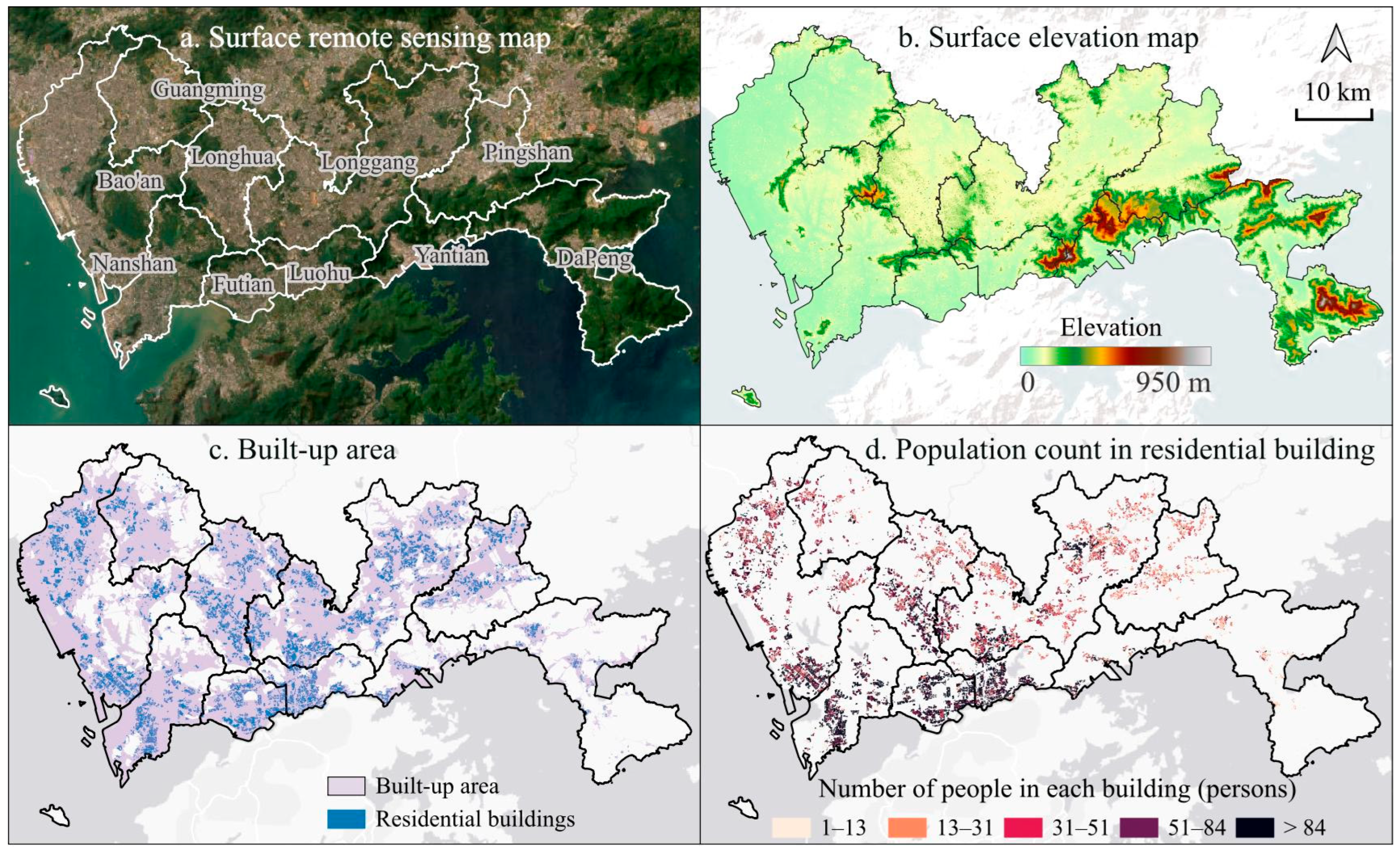
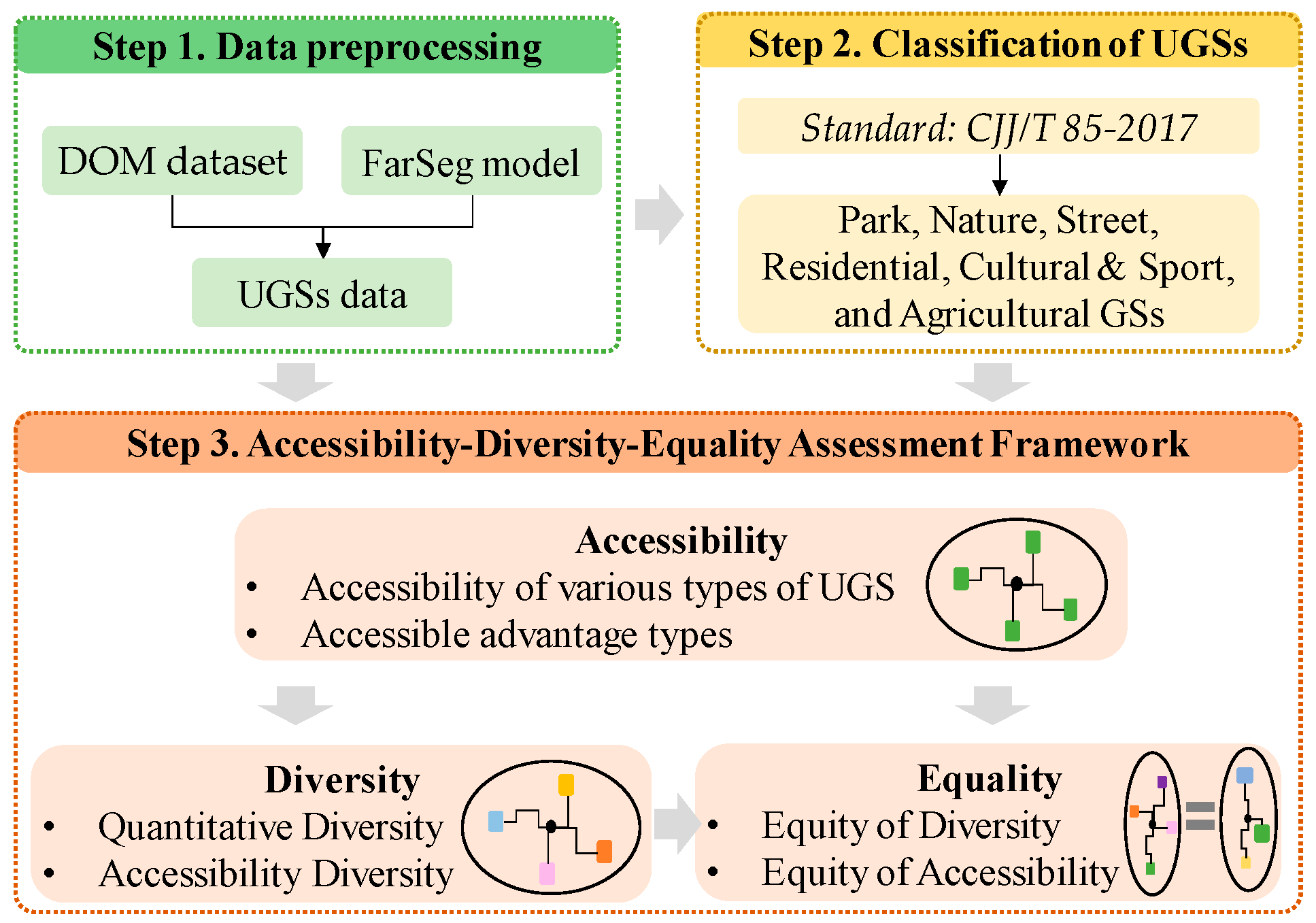

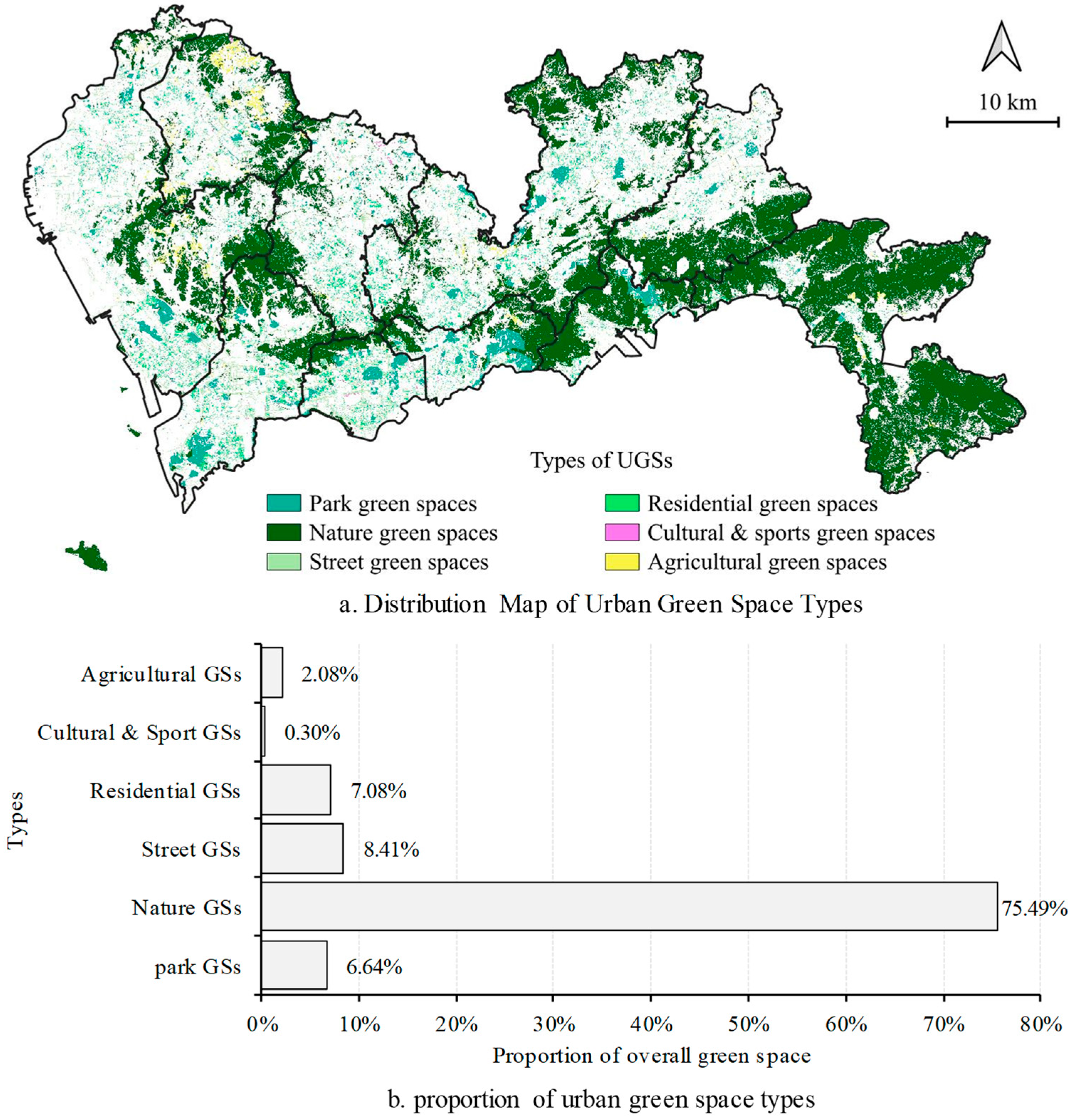
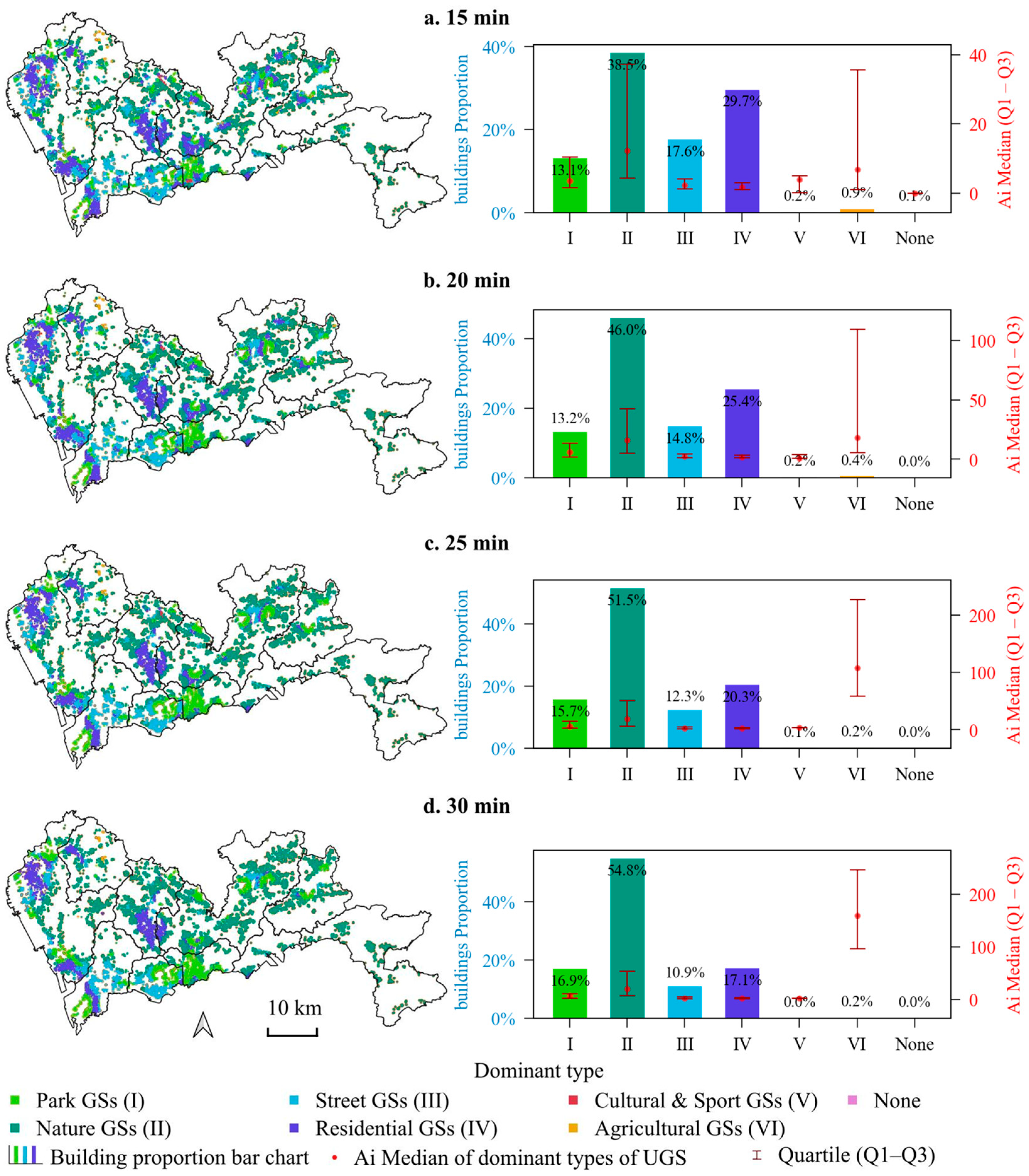

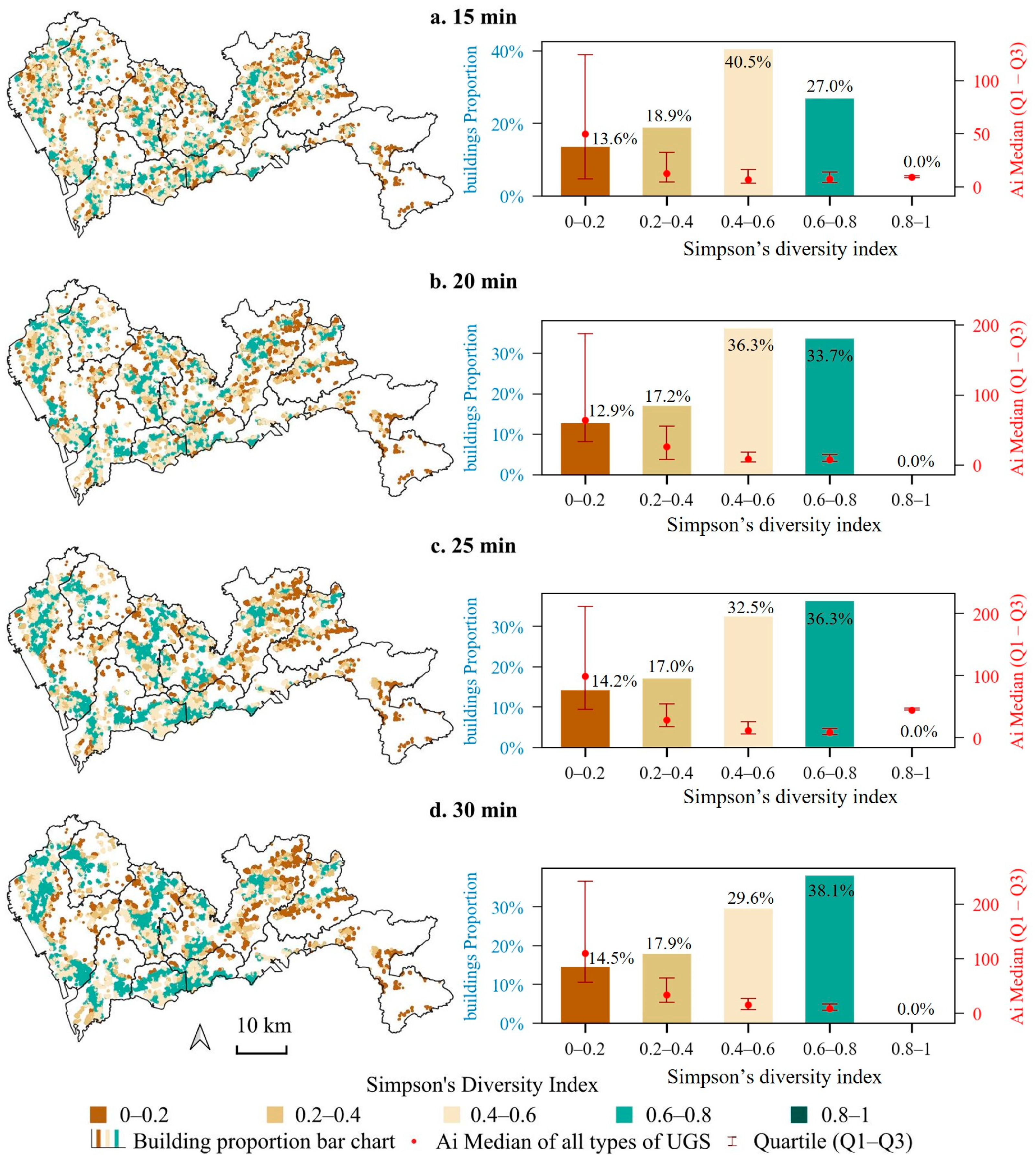

| Dataset | Usage | Source |
|---|---|---|
| Gaofen-1 satellite imagery | Used for extracting UGSs | https://www.sasclouds.com/chinese/normal (accessed on 8 July 2025) |
| Open Street Map road network | Employed to compute accessibility time to UGSs | http://www.openstreetmap.org (accessed on 7 June 2025) |
| Residential building data | Functioned to identify demand locations | Amap: https://amap.com (accessed on 8 July 2025), Building rooftop: https://doi.org/10.11888/Geogra.tpdc.271702 (accessed on 8 July 2025), CNBH-10m: https://zenodo.org/record/782731 (accessed on 8 July 2025) |
| Urban land-use data | Employed for UGSs typology classification | Official land survey basemap |
| Point-of-interest data | Served for residential population estimation | https://lbs.amap.com (accessed on 8 July 2025) |
| Mobile signaling data | Served for residential population estimation | Provided under license by China Unicom’s Smart Footprint platform |
| Category | Definition | The Name Corresponding to the Standard |
|---|---|---|
| Park Green Spaces | Public green spaces primarily for recreation. | Parks and squares green spaces |
| Natural Green Spaces | Undeveloped or minimally developed non-urbanized green spaces. | Regional green spaces |
| Street Green Spaces | Green spaces along roads, including street trees, green belts, and roadside pocket parks. | Ancillary green spaces in urban road land |
| Residential Green Spaces | Green spaces within residential areas. | Ancillary green spaces in residential land |
| Cultural and Sports Green Spaces | Green spaces in museums, exhibition halls, and sports facilities. | Ancillary green spaces in cultural and sports facilities |
| Agricultural Green Spaces | Green spaces dominated by farming (e.g., croplands, orchards). | Green spaces in agricultural land |
| Variable | UGS Types | 15 min | 20 min | 25 min | 30 min |
|---|---|---|---|---|---|
| Accessibility of various GSs | Park GSs | 0.88 | 0.83 | 0.77 | 0.73 |
| Nature GSs | 0.94 | 0.92 | 0.91 | 0.90 | |
| Street GSs | 0.67 | 0.62 | 0.57 | 0.53 | |
| Residential GSs | 0.58 | 0.52 | 0.48 | 0.45 | |
| Cultural and Sport GSs | 0.95 | 0.91 | 0.86 | 0.81 | |
| Agricultural GSs | 0.98 | 0.98 | 0.96 | 0.95 | |
| All types of GSs | 0.77 | 0.76 | 0.74 | 0.73 | |
| Diversity of accessible GSs | Type count | 0.13 | 0.11 | 0.10 | 0.09 |
| Simpson index | 0.21 | 0.19 | 0.19 | 0.19 |
Disclaimer/Publisher’s Note: The statements, opinions and data contained in all publications are solely those of the individual author(s) and contributor(s) and not of MDPI and/or the editor(s). MDPI and/or the editor(s) disclaim responsibility for any injury to people or property resulting from any ideas, methods, instructions or products referred to in the content. |
© 2025 by the authors. Licensee MDPI, Basel, Switzerland. This article is an open access article distributed under the terms and conditions of the Creative Commons Attribution (CC BY) license (https://creativecommons.org/licenses/by/4.0/).
Share and Cite
Chang, F.; Huang, Z.; Liu, W.; Huang, J. A Novel Framework for Assessing Urban Green Space Equity Integrating Accessibility and Diversity: A Shenzhen Case Study. Remote Sens. 2025, 17, 2551. https://doi.org/10.3390/rs17152551
Chang F, Huang Z, Liu W, Huang J. A Novel Framework for Assessing Urban Green Space Equity Integrating Accessibility and Diversity: A Shenzhen Case Study. Remote Sensing. 2025; 17(15):2551. https://doi.org/10.3390/rs17152551
Chicago/Turabian StyleChang, Fei, Zhengdong Huang, Wen Liu, and Jiacheng Huang. 2025. "A Novel Framework for Assessing Urban Green Space Equity Integrating Accessibility and Diversity: A Shenzhen Case Study" Remote Sensing 17, no. 15: 2551. https://doi.org/10.3390/rs17152551
APA StyleChang, F., Huang, Z., Liu, W., & Huang, J. (2025). A Novel Framework for Assessing Urban Green Space Equity Integrating Accessibility and Diversity: A Shenzhen Case Study. Remote Sensing, 17(15), 2551. https://doi.org/10.3390/rs17152551








